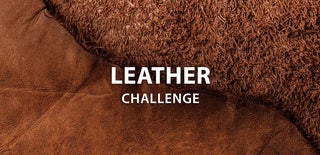Introduction: So You Want to Do a Leathercraft...
Congratulations. You've picked one of the best stress relieving hobbies you possibly can.
Who doesn't want to hit things with a hammer ? Who in there right mind doesn't find stitching relaxing?
Also. Given the right market, things you can make are always in demand.
I'll try and give you a little heads up of what to expect and how to approach your new hobby.
Step 1: Tools. Kinda.
You don't need a massive selection of tools to start.
You'll need needles, thread, something to make holes in the leather (if its thick) and... thats it!
Your project will initially look a little rough, but that why you're making things. You'll get better!
The hardest part is starting.
I've included some of my earliest work to show that everyone starts somewhere.
Initially things like your pricking irons can be substituted with a sharpened fork or an improvised awl, as your skill increases I would suggest getting your hands on higher quality leather and finishing tools. You can get your hands on chrome tanned leather on eBay
Sure, some of it will be trash, but its nice to be able to stitch things together to make something. Its usually a thinner leather so its easier to stitch, and its brightly coloured so its handy for making small bags or book covers.
You can also get veg tan leather "splits" if you want to practice on something tougher.
I would initially suggest investing in a stitch marker; they are cheap and will improve your work drastically.
One of the most noticeable things about your projects will be your stitch lines, or lack thereof. You can substitute things like a compass to mark edges. You can see where I've messed up on the dog treat pouch.
A cutting mat and a craft knife set are worth buying too.
Later, you can buy a cheap tool kit from amazon. here is a good start; after a few projects I held my nose and bought something similar to this. I have not looked back.
Not that you need to stitch if its not your thing! The bracelet is made from scrap leather and a punch, then woven together.
Step 2: The First Thing Is "What Do You Want to Make ?"
Take some time and draw out what you want to make.
Want a handbag ? at minimum it will need a front a back and a gusset to connect them. It'll also need a strap that should be adjustable, and likely some way to connect that to the bag.
I would suggest starting small. This is a headphone case. Its two circles of leather stitched together with a little carving on the front. The glasses case is a single stitch. The hatband is a weave.
Take some time and draw out what you want, have a guess about dimensions.
If you're in a hurry, you can also buy acrylic templates from eBay or similar sites.
Remember, you can use patterns for other textiles and they'll work well for leather too!
Step 3: Draw It Out
In this example we'll use my weekend bag.
This is the schematic. I've drawn a picture of what I want it to look like added rough dimensions, then planned all the pieces I will need to make it.
I made a few mistakes (the side pockets are not where they should be) but it was a fun build!
Step 4: So What Leather.
This is a box pouch I made for my belt.
Its made from an old horse saddle so the outlay for this product was maybe £25 including brass.
You dont need the best quality leather to make something pretty. The bear I showed earlier was made from chrome offcuts.
Step 5: Getting Fancy.
Don't think everything you are doing has to be low tech.
There is absolutely nothing stopping you from hauling your leather out in front of a laser like a Bond villan and carving rabbits on it. Its your hobby. The fact it is often unique is the selling point.
In any case where your carving is likely to be difficult, I would suggest either drawing out your pattern on tracing paper and then scratching it into the leather with an awl, or using a stamp or a laser.
If you have access to a 3D printer, you can also print off your own logo designs (remember to print them mirrored) Its a useful skill if you want to make a personalised keyfob.
Embellishments sell incredibly well. This is pheasant feather in a 9mm brass casing.
Tl:Dr the limit is what you want to make. Take stuff apart and rearrange it.
Thank you for reading!
Good Luck and Happy Crafting!
Step 6: Tips and Tricks
Real rivets sell better. Copper is easier to cut and shape; brass is prettier. Remember, you can mix and match.
Buy a cutting mat, your tools will thank you
A strap cutter is your friend, as is an arbour press.
This rotary cutter is amazing. Its ideal for nice clean lines.
There is usually a right tool for the job; round end cutters are fantastic as are curved 90 degree punches.
Finally - remember you can cut bits off, but its hard to add bits back on.

Participated in the
Leather Challenge









